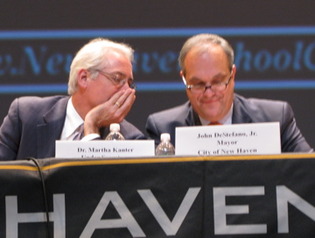 As New Haven got national plaudits in a star-studded media event, the real action took place offstage — where the mayor pushed federal visitors to free up stimulus money to pay for school reform.
As New Haven got national plaudits in a star-studded media event, the real action took place offstage — where the mayor pushed federal visitors to free up stimulus money to pay for school reform.
The plaudits came on the stage of the new Co-op High School’s main theater, where the head of the national American Federation of Teachers and two top guns from the U.S. Department of Education (DOE) joined local officials Monday afternoon in celebrating the city’s new teacher’s contract.
The work came behind the scenes, in a close-door forum before the public event.
The day’s events came on the heels of an agreement on a three-year teacher contract, which teachers overwhelmingly ratified by a vote of 842 to 39 on Oct. 13. The contract opens the door to major reforms in the school system, including tying teacher evaluations to student performance and closing failing schools and reopening them as charters.
New Haven got major praise from both union and government officials for coming to an agreement on major changes in the classroom, which have faced resistance from teachers in other cities.
But in a private session, no agreement was reached on whether federal and state leaders will take actions needed to allow millions of government dollars to support New Haven’s experiment.
Public Plaudits
New Haven’s contract “can serve and will serve as a national model,” Charles Rose, general counsel of the DOE (in photo above with DeStefano), declared at Monday’s public event.
(Click here to watch videos of the public event made by State Rep. Gary Holder-Winfield.)
 AFT President Randi Weingarten (pictured) agreed. “I don’t normally talk about contracts as models, but this one is special,” she said. She called it “a model of both process and outcome.”
AFT President Randi Weingarten (pictured) agreed. “I don’t normally talk about contracts as models, but this one is special,” she said. She called it “a model of both process and outcome.”
Weingarten commended the city for not blaming teachers, but instead asking them what they need to do their jobs. Unlike in Washington, D.C., labor and administration found common solutions instead of “screaming at” each other, she said.
 Undersecretary of Education Martha Kanter (pictured) praised what she called unique contract language that sets up three committees that will give teachers and parents input in the reforms.
Undersecretary of Education Martha Kanter (pictured) praised what she called unique contract language that sets up three committees that will give teachers and parents input in the reforms.
Rose pointed to teachers’ willingness to put everything on the table. The city’s reform effort “mirrors” the priorities of President Obama’s administration as it pushes for nationwide reforms, he said. Public education reform will take place at the local level, in labor contracts like New Haven’s, he said. He issued a challenge to other communities to follow suit.
The three guests joined Mayor John DeStefano, schools superintendent Reggie Mayo and New Haven Federation of Teachers President David Cicarella, for a 90-minute panel before an audience of about 300 people.
The panelists stood in such agreement that at one point the moderator, Hartford Courant Columnist Rick Green, declared the forum “bad for the media business.” “This has to stop,” he joked.
By the end of the roughly 90-minute forum, DeStefano said he felt “overly self-congratulated.” When students go back to school tomorrow, he noted, nothing will have changed yet.
“Group Date”
DeStefano said the real work Monday came behind the scenes, before the public spotlight.
 Before the forum, DeStefano gathered 50 decision-makers in an upstairs room at Co-op for what he called a big “group date.” In the room, the national visitors were joined by: state education officials, top state legislators, the city school board, philanthropic supporters, school officials, representatives from federal legislators’ offices, and the presidents of Yale, Southern Connecticut State University and Gateway Community College.
Before the forum, DeStefano gathered 50 decision-makers in an upstairs room at Co-op for what he called a big “group date.” In the room, the national visitors were joined by: state education officials, top state legislators, the city school board, philanthropic supporters, school officials, representatives from federal legislators’ offices, and the presidents of Yale, Southern Connecticut State University and Gateway Community College.
The meeting served to build consensus between a large group of people around the city’s plans, as well as to tackle stumbling blocks in the way of reform, he said.
It wasn’t all Kumbaya when it came to dollars and cents.
DeStefano is seeking $130 million in supplemental money over five years to finance an ambitious school reform drive that would cut the dropout rate in half, close the achievement gap, and ensure each student makes it through college. The teacher’s contract was the first step; now he’s looking to federal, state and private funders to help make it happen. He’s counting on being rewarded from D.C. for the breakthrough labor agreement.
New Haven has its sights on two federal grants, Investing In Innovation and the Race to the Top Fund, which are part of an unprecedented $5 billion federal stimulus program supporting school reform.
The Department of Education guests were asked if their visit indicates that New Haven is in line for those federal dollars. Rose told the Independent he can make no promises. He came to highlight New Haven’s work, but not to endorse it for the grant, he said.
In the private meeting, DeStefano brought up a few roadblocks in the way of that money.
One: New Haven is currently ineligible for the Investing In Innovation grant. That grant would directly fund school districts to “start or expand research-based innovative programs that help close the achievement gap and improve outcomes for students.”
New Haven doesn’t qualify because its schools have failed two consecutive years to meet average yearly progress guidelines set by the No Child Left Behind Act. That requirement disqualifies many urban districts. U.S. Secretary of Education Arne Duncan has said he intends to change those guidelines, but doing so requires a change in federal law.
Representatives from the offices of U.S. Rep. Rosa DeLauro, U.S. Sens. Chris Dodd and Joe Lieberman were in the room Monday. They pledged to help get that law changed, the mayor said.
Two: DeStefano is counting on the state to bring in money from the $4.35 billion Race to the Top Fund for New Haven. But the state may be disadvantaged because of how Gov. M. Jodi Rell handled previous stimulus money.
The Race to the Top Fund is given to states, which apply on behalf of local districts. DeStefano said he worked hard to align New Haven’s priorities to those of Race to the Top, including teacher evaluations, differentiated management of schools, and a focus on using student performance data. The state has pledged to include New Haven in its application to the grant.
However, a problem recently surfaced may hurt the state’s application to the fund. Connecticut got in hot water with the inspector general for the Department of Education last month over how Gov. Rell used previous stimulus money. In a Sept. 30 memo, the inspector general’s office pointed to Connecticut, Pennsylvania and Massachusetts as examples of states that used stimulus money to plug budget holes instead of to stimulate growth.
DeStefano said he raised the topic and it provoked a “defensive” reaction from state officials.
 George Coleman (pictured), Connecticut’s deputy education commissioner, explained the state’s case after the meeting. He said Gov. Rell decided to use the stimulus money to fill a shortfall in education funds and make good on a promise to flat-fund education money for towns.
George Coleman (pictured), Connecticut’s deputy education commissioner, explained the state’s case after the meeting. He said Gov. Rell decided to use the stimulus money to fill a shortfall in education funds and make good on a promise to flat-fund education money for towns.
Federal DOE officials “were fully aware of how we anticipated spending it,” he said. But when the DOE guidelines came out, they sent a different message — don’t use this money to make up for recession-era shortfalls in the budget. Rell went ahead with her original plan, which broke federal guidelines. State and federal officials have since been straightening things out, Coleman said.
“The governor is feeling fairly confident” that the problem will be cleared up, Coleman said.
He praised New Haven’s plans as a model for the state. Having everyone in the same room Monday “set the table” for reform, he said.
Hard Work Begins
Meanwhile, New Haven will set to work on the nuts and bolts of the ambitious plans.
As called for in the teacher contract, the city will soon set up three committees: the Reform Committee, comprised of three teachers, three administrators and two parents, will recommend how to measure student performance.
The Teacher Evaluation Committee will draft guidelines that will tie teacher evaluations to student performance as well as set up peer assistance and peer review for low-performing teachers.
A third committee will draft School Climate Surveys with input from the AFT and others.
The aim is to grade schools into three tiers, with preliminary rankings ready by March 10, 2010. Tier 1 will be high-performing, Tier 3 the lowest. The mayor said he hopes to focus on eight schools — two in each tier, plus two “turnaround” schools in the low-performing rank, and craft improvement plans to debut in the fall of 2010. The turnaround schools would be closed and reopened under new rules and new management, as charter schools with unionized staff.
The details of the reforms — including whether any schools will be reconstituted next year, and what new rules they’ll reopen with — will be hashed out in those committees, noted Cicarella, the local union president.
“The hard work has just begun,” agreed his colleague, union Vice President Tom Burns.
Some previous stories about New Haven’s school reform drive:
• Mayor “Not Scared” By $100M
• Useful Applause: Duncan, AFT Praise City
• Reformer Moves Inside
• After Teacher Vote, Mayo Seeks “Grand Slam”
• Will Teacher Contract Bring D.C. Reward?
• What About The Parents?
• Teachers, City Reach Tentative Pact
• Philanthropists Join School Reform Drive
• Wanted: Great Teachers
• “Class of 2026” Gets Started
• Principal Keeps School On The Move
• With National Push, Reform Talks Advance
• Nice New School! Now Do Your Homework
• Mayo Unveils Discipline Plan
• Mayor Launches “School Change” Campaign
• Reform Drive Snags “New Teacher” Team
• Can He Work School Reform Magic?
• Some Parental Non-Involvement Is OK, Too
• Mayor: Close Failing Schools
• Union Chief: Don’t Blame The Teachers
• 3‑Tiered School Reform Comes Into Focus
• At NAACP, Mayo Outlines School Reform
• Post Created To Bring In School Reform
• Board of Ed Assembles Legal Team